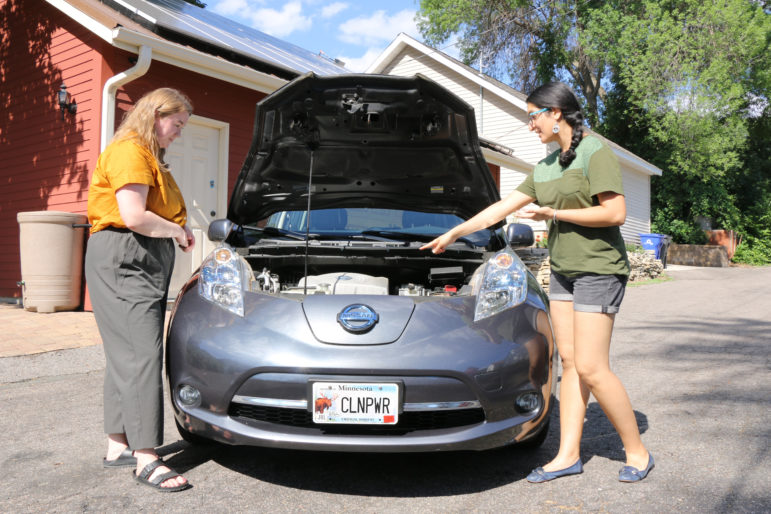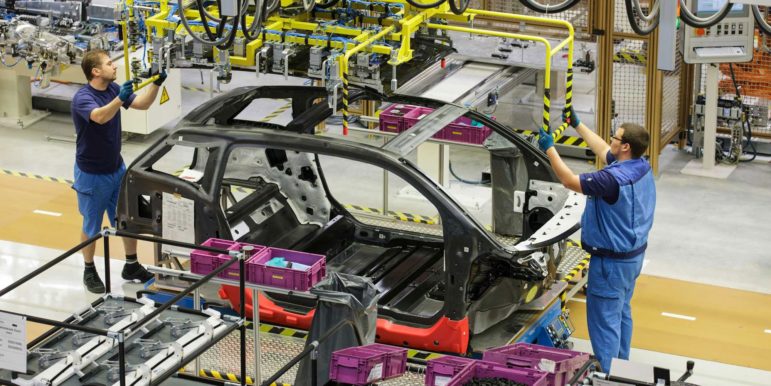
In a nutshell:
– Electric vehicles use batteries similar to other electronics, and also require resource extraction (e.g. mining) like many other modern consumer products.
– We are at the beginning of the transition to electric vehicles and can build a better and more sustainable supply chain that both meets our climate needs and has adequate labor and environmental safeguards.
– By reducing the amount of minerals needed for batteries through technology innovation and reduced personal vehicle use, reusing batteries for second- and third-life applications, and recycling them at their end-of-life, EVs will become more sustainable.
– In almost every U.S. state, EVs produce fewer emissions than the average gasoline-powered car—and as our electric grid continues to rapidly decarbonize, EVs will become even more climate-friendly.
Electric vehicles are everywhere these days. You likely can’t skim a newspaper, tune into your morning radio program, or even read a Fresh Energy newsletter without hearing something about them, be it Ford’s debut of its all-electric Ford F150 or whether electric vehicle charging stations will be included in a federal infrastructure bill. Electric vehicles are having their day in the sun, which is great considering their many health, climate, and consumer benefits.
Of course, with attention comes scrutiny. Electric vehicle batteries, both their materials and production, are being vigorously debated and analyzed by news media and lawmakers alike (if you’ve read our cobalt blog post, you’ll know what we mean). Here at Fresh Energy, we’ve done our part to dispel misinformation publicly and at the state legislature by doing media interviews, hosting events, writing memos, and testifying—but with so many hot takes swirling around, it can be difficult to separate truth from hyperbole. To make sense of it all, we decided to wade in and pull out what you need to know. Let’s dive in!
Basics: Why the focus on batteries?
Let’s start with the basics. Internal combustion engine (ICE) vehicles are propelled by engines that burn fossil fuels, like gasoline or diesel. Electric vehicles (EVs) are propelled by batteries that run on electricity, either fully or partially (i.e. plug-in hybrids). The electricity used by EVs is generated the same way all our electricity is generated—by a mix of power sources that include hydro, wind, solar, nuclear, natural gas, and coal.

Given how salient the discussion around EV batteries is right now, it can be easy to forget that the batteries that power electric vehicles use roughly the same technology (e.g. lithium-ion) that power our consumer electronics. So, when we talk about the supply chain for EV batteries, we are also commenting on the entire battery supply chain for products like our cell phone and laptop batteries.
EV batteries have the spotlight though. This attention stems from the general EV buzz we mentioned as well as EV batteries’ relatively large size. Add to this the expected ramp-up in EV manufacturing and sales over the next decade and you get a recipe for a lot of interest and concern since these batteries, like many of our modern-day products, require materials that are mined from the Earth. We address this next.
Bottom line: Electric vehicles use batteries similar to other electronics, and also require resource extraction (e.g. mining) like many other modern consumer products.
EV Supply Chain: What’s past need not be prologue
Current EV battery technology typically utilizes minerals like lithium, cobalt, and nickel, which require resource extraction like mining. Much of the concern around the accelerated adoption and production of EVs comes from seeing the current, unsustainable, and unethical mining practices for these minerals, and multiplying their impacts into the future. This line of thinking can cast a shadow over the future of EVs, and quickly leads to skeptics declaring EVs as harmful rather than helpful. What these snappy headlines often miss, however, is nuance and context. Three points in particular are crucial to understand:
- EVs are at the inflection point of their expected adoption curve, which means the majority of resource extraction required for battery production has not yet occurred—i.e. the future is not locked in;
- EVs have gained traction at a time when issues of equity and justice are prominent in public discourse, which means there is additional scrutiny from journalists, lawmakers, and the general public on regulators and companies to “get things right” with EVs; and
- Initiatives are already underway to make the clean energy supply chain cleaner and safer, for EVs and other clean technology—and supply chain is also a topic of intense interest for the Biden-Harris Administration.
Taken together, these points underscore the unique position EVs are in. Their manufacturers have the opportunity to do what almost no other industry has done before: build a safe and sustainable supply chain that doesn’t sacrifice health or the environment in pursuit of rapid growth.
Realizing this goal will take deliberate effort and coordination across multiple sectors (e.g. mining and automakers) and diverse stakeholders such as governments, nonprofits, organized labor, and communities. The good news? The work is already underway. A remarkable example lies in the Initiative for Responsible Mining Assurance, or IRMA. Started in 2006, it unites a broad set of stakeholders to come up with standards for socially and environmentally responsible mining. These standards are then used to certify mines that opt-in. While it’s up to each mine to adhere to IRMA standards, a number of automakers like Ford Motor Co. and the BMW Group are part of IRMA too, an acknowledgment of the role and influence they wield over mines as major purchasers of their minerals.

As Sue Slaughter, purchasing director for supply chain sustainability at Ford, told the New York Times in May 2021, “We really want to force the industries that we’re buying materials from to make sure that they’re doing it in a responsible way. As an industry, we are going to be buying so much of these materials that we do have significant power to leverage that situation very strongly. And we intend to do that.”
Other initiatives are also underway, from both private market participants and public entities. Automakers have banded together to launch “Drive Sustainability,” an effort to source raw materials for battery production in an ethical and socially responsible manner. Private and public groups, including automakers, governments, nonprofits, and academics, have also launched the Global Battery Alliance, a partnership committed to building a responsible and circular supply chain for batteries.
While these voluntary efforts are admirable, regulation is also important as a backstop to these good intentions. The European Union (EU) has been proactive, issuing regulation on batteries and waste management in 2006 and following up in December 2020 with updates to ensure batteries used in the EU are “sustainable, high-performing, and safe all along their entire life cycle.”
The U.S., on the other hand, has room for improvement. Most mining laws and regulations have not been updated for over 50 years, despite mining activity increasing and processes evolving. Add to this the harm many Native nations have endured due to these lax policies, and it’s clear many things need to change for the U.S. to become a sustainable, responsible source of battery minerals.

A small silver lining: our federal government knows it. This spring, the Biden-Harris Administration issued a comprehensive review of the U.S. supply chain, including materials required for EV battery production. Acknowledging the outdated U.S. mining laws and regulations, the report recommended developing more rigorous environmental and labor standards, stating that “federal agencies and state governments must hold raw mineral production to modern environmental standards, require best-practice labor conditions, and proceed with meaningful consultation with affected communities, including Tribal nations in government-to-government collaboration.” A model for doing so, the report notes, is IRMA.
All this activity underscores a crucial point: achieving our climate goals does not require compromising on other environmental and community impacts. While it will take a concerted effort, both voluntary and regulated, the truth is that the EV industry can build an environmentally and socially responsible supply chain.
Bottom line: We are at the beginning of the transition to electric vehicles and can build a better and more sustainable supply chain that both meets our climate needs and has adequate labor and environmental safeguards.
Follow the Rs: Reduce, Reuse, Recycle

We all know the three Rs: reduce, reuse, recycle. These principles are readily applied to EVs and, alongside responsible mining, are cornerstones to building a sustainable supply chain.
Reduce…demand for personal vehicles. While it’s true that EVs will be necessary substitutes to the passenger cars and trucks many people drive today, reducing our reliance on personal vehicles is also crucial. Alternatives like electrified public transit, EV carsharing and ridesharing, and active transportation like walking and biking must be built and expanded across Minnesota and the U.S. to achieve our climate and equity goals. While the approach will differ based on geographic and cultural constraints and needs, the result will be lower battery demand, thereby reducing pressure on the battery supply chain.
Reduce…demand for minerals. Battery technology is innovating rapidly. Batteries of the future will provide more power with fewer—and likely different—source materials. This innovation will reduce the need for minerals like cobalt which, in some parts of the world, are prone to untenable labor and environmental impacts. While initiatives like IRMA can improve these mining issues, lessening the demand for mining by reducing the minerals required per battery will also help. Automakers like Tesla and General Motors have developed new methods of battery production that either eliminate or vastly reduce the amount of cobalt required. And in India, companies are exploring aluminum batteries as a complete alternative to lithium-ion batteries.
Reuse…for storage. EV batteries are primed for reuse after their initial use to propel vehicles. EV batteries degrade over time, meaning that vehicle range decreases as the battery’s ability to hold electric charge decreases. At a certain point, the range decrease may prove inadequate for the primary vehicle user. At that point, the EV can find a second life as a used vehicle for someone who travels fewer miles on average—like an urban resident or part-time commuter. The degraded EV battery could also be repurposed either as a home storage option or, increasingly, as a grid storage asset. U.S. companies like RePurpose and Smartville are springing up to address this potential second-life use.
Recycle…to source minerals. Multiple reports attest to recycling’s ability to reduce global demand for new battery minerals. One recent report noted 90 percent recovery of minerals like lithium and cobalt is technically possible today, and that such recycling could reduce overall global demand by 2040 for new minerals like lithium by 25 percent, and nickel and cobalt by 35 percent. Another report summarized by the Union of Concerned Scientists found that by recovering 95 percent of these minerals and using less or no cobalt, the U.S. “could meet about 30 to 40 percent of the anticipated material demand for lithium, nickel, cobalt, and graphite in passenger [fully electric vehicles] with recycled battery materials by 2035.” Policies and regulations to spur these high levels of battery recycling will be necessary as this report from Berkeley Law notes, as well as investment to create a domestic industry to handle large-scale recycling. Already the U.S. Department of Energy has issued a challenge to improve lithium-ion battery recycling, and a few U.S.-based companies have also formed to address this opportunity, like Redwood Materials, Li-Cycle, and our very own Minnesota-connected Exsolve Recycling.
Bottom line: By reducing the amount of minerals needed for batteries through technology innovation and reduced personal vehicle use, reusing batteries for second- and third-life applications, and recycling them at their end-of-life, EVs will become more sustainable.
Lifecycle Emissions: So are EVs actually good for our climate?
With all the discussion on mining and battery production, doubt can creep into the benefits of EVs. It’s natural to ask whether EVs do help lower greenhouse gas emissions compared to their gasoline counterparts. The good news: EVs do indeed emit fewer climate-change causing emissions than gasoline-powered vehicles over their lifetime, even when factoring in mining and battery production.
Of course, context is key. Almost everything we manufacture emits climate change- causing greenhouse gases (GHGs), and battery production is no exception. During manufacturing, EVs tend to require more resources (i.e. energy and materials) than their fossil fuel counterparts. This means that during manufacturing, EVs have slightly higher emissions than gasoline-powered vehicles on average.
However, lifecycle emissions (i.e. making and using a vehicle) are what really matters. Once an EV is built, it operates on electricity, an activity which is increasingly cleaner than burning gasoline in the U.S. That means EVs can “work off” those slightly higher upfront emissions within 6 to 16 months of use. As our electric grid across the U.S. and here in Minnesota continues to get cleaner—thanks to common-sense decisions like not building new fossil fuel infrastructure—EV lifecycle emissions will drop as well, both in operation and production as battery and EV manufacturers and EV drivers use electricity powered more and more by renewable energy. A recent study by the International Council on Clean Transportation found that EVs currently registered in the U.S. already emit 60 to 68 percent fewer GHGs than comparable gasoline cars. To top it all off, EVs can be set to charge when carbon-free energy like wind is most abundant, dropping their operating emissions even further. Amazing!
Bottom Line: In almost every U.S. state, EVs produce fewer emissions than the average gasoline powered car—and as our electric grid continues to rapidly decarbonize, EVs will become even more climate-friendly.
What’s Next: Building the future we need
“The future of the auto industry is electric. There’s no turning back.”
An electric future may be inevitable, but what it will look like is not. Voluntary initiatives like IRMA and the Global Battery Alliance combined with rigorous environmental and labor standards and respect for Indigenous sovereignty and treaty rights here in the U.S. and abroad will be crucial to building a truly sustainable EV industry. The U.S. in particular stands to benefit from investing in a responsible domestic supply chain and battery production, two areas our country lags in but which, if done right, can lead to jobs in multiple sectors, including in recycling and second-life uses.
Fresh Energy will keep doing its part to build a sustainable and equitable future, and, as we come off a major success in Clean Cars Minnesota, we will continue to hone and advocate for policies that support a swift transition to electric transportation that uses carbon-free electricity and benefits all Minnesotans.
Want to dive in deeper? Check these out:
- Initiative for Responsible Mining (IRMA) homepage
- Electric Vehicle Batteries: Addressing Questions about Critical Materials and Recycling (Union of Concerned Scientists, February 2021)
- Reducing new mining for electric vehicle battery metals: responsible sourcing through demand reduction strategies and recycling (Prepared for Earthworks by the Institute for Sustainable Futures, April 2021)
- Building Resilient Supply Chains, Revitalizing American Manufacturing, and Fostering Board-Based Growth (The White House, June 2021) – Fact Sheet
- Recycling: a key in the U.S. quest for lithium-ion battery supply chain relevancy (PV Magazine, July 2021)
- A global comparison of the life-cycle greenhouse gas emissions of combustion engine and electric passenger cars (The International Council on Clean Transportation, July 2021)

